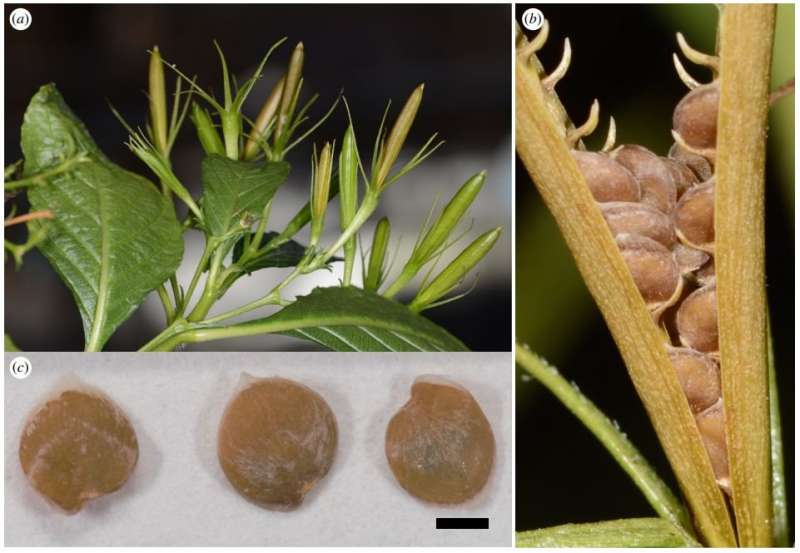(a) Ruellia ciliatiflora plant in greenhouse with mature (brown) and immature (green) fruits ( photo credit Erin Tripp), (b) the inside of a fruit that was constrained during dehiscence. The seeds are cradled by, but not attached to, the retinacula ( photo credit Erin Tripp), (c): three seeds from a single fruit with 1 mm scale bar ( photo credit Jeremy Wright). Credit: Journal of The Royal Society Interface (2018). DOI: 10.1098/rsif.2017.0901
A team of researchers from Pomona College and the Rancho Santa Ana Botanic Garden has figured out how a wild petunia plant is able to fling its seeds so far. In their paper published in the Journal of the Royal Society Interface, the team outlines their study of the plant and its seeds and what they found.
The hairyflower wild petunia (aka Ruelia), an ornamental flowering plant, is not actually very closely related to petunias, though it does produce pretty flowers. What is most striking about the plant is the way it disperses its seeds—by flinging them great distances when its fruit is exposed to water. But until now, little research has been done to find out how the flower flings them so far. To learn more, the researchers brought some of the plants into their lab and filmed seed dispersal using a high-speed camera.
The researchers discovered that there are multiple factors at play. One is the glue-like material that holds the seeds in place, another is the disc shape of the seeds. Little hooks behind the seeds also assist in launching them. Perhaps most importantly, spin develops due to the way the seed is flung. In slowing down the action, the researchers observed that the seeds spin up to 1,660 times per second, making them the fastest spinners known in nature.
The videos offered evidence of the assist the seeds get from spinning—some of those ejected did not spin, and only traveled half as far as those that did. And those that did were able to travel as far as seven meters and were launched at speeds up to 22 miles per hour. Oddly, they spin vertically and counterclockwise, like a Frisbee on its side. The spin, the researchers found, resulted in a gyroscopic effect, keeping the seeds stabilized while the backspin produced less drag, keeping the seeds aloft longer and thus allowing them to fly farther.
Prior research has suggested that dispersing seeds great distances offers plants a better chance of survival as it prevents the new plants from competing with one another.
More information: Eric S. Cooper et al. Gyroscopic stabilization minimizes drag on Ruellia ciliatiflora seeds, Journal of The Royal Society Interface (2018). DOI: 10.1098/rsif.2017.0901
Abstract
Fruits of Ruellia ciliatiflora (Acanthaceae) explosively launch small (2.5 mm diameter × 0.46 mm thick), disc-shaped seeds at velocities over 15 m s−1, reaching distances of up to 7 m. Through high-speed video analysis, we observe that seeds fly with extraordinary backspin of up to 1660 Hz. By modelling the seeds as spinning discs, we show that flying with backspin is stable against gyroscopic precession. This stable backspin orientation minimizes the frontal area during flight, decreasing drag force on the seeds and thus increasing dispersal distance. From high-speed video of the seeds' flight, we experimentally determine drag forces that are 40% less than those calculated for a sphere of the same volume and density. This reduces the energy costs for seed dispersal by up to a factor of five.
Journal information: Journal of the Royal Society Interface
© 2018 Phys.org
























